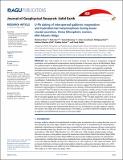| dc.contributor.author | Jöns, Niels | |
| dc.contributor.author | Lissenberg, C. Johan | |
| dc.contributor.author | Bach, Wolfgang | |
| dc.contributor.author | Kylander-Clark, Andrew | |
| dc.contributor.author | Hacker, Bradley | |
| dc.contributor.author | Rioux, Matthew | |
| dc.contributor.author | Bowring, Samuel A. | |
| dc.contributor.author | Dudas, Francis O. | |
| dc.date.accessioned | 2018-09-25T15:58:26Z | |
| dc.date.available | 2018-09-25T15:58:26Z | |
| dc.date.issued | 2015-04 | |
| dc.date.submitted | 2014-10 | |
| dc.identifier.issn | 2169-9356 | |
| dc.identifier.issn | 2169-9313 | |
| dc.identifier.uri | http://hdl.handle.net/1721.1/118167 | |
| dc.description.abstract | New U/Pb analyses of zircon and xenotime constrain the timing of magmatism, magmatic assimilation, and hydrothermal metamorphism during formation of the lower crust at the Mid-Atlantic Ridge. The studied sample is an altered gabbro from the Vema lithospheric section (11N). Primary gabbroic minerals have been almost completely replaced by multiple hydrothermal overprints: cummingtonitic amphibole and albite formed during high-temperature hydration reactions and are overgrown first by kerolite and then prehnite and chlorite. In a previous study, clear inclusion-free zircons from the sample yielded Th-corrected ²⁰⁶Pb/²³⁸U dates of 13.528±0.101 to 13.353±0.057Ma. Ti concentrations, reported here, zoning patterns and calculated Th/U of the dated grains are consistent with these zircons having grown during igneous crystallization. To determine the timing of hydrothermal metamorphism, we dated a second population of zircons, with ubiquitous <1-20μm chlorite inclusions, and xenotimes that postdate formation of metamorphic albite. The textures and inclusions of the inclusion-rich zircons suggest that they formed by coupled dissolution-reprecipitation of metastable igneous zircon during or following hydrothermal metamorphism. Th-corrected ²⁰⁶Pb/²³⁸U dates for the inclusion-rich zircons range from 13.598±0.012 to 13.503±0.018Ma and predate crystallization of all but one of the inclusion-free zircons, suggesting that the inclusion-rich zircons were assimilated from older hydrothermally altered wall rocks. The xenotime dates are sensitive to the Th correction applied, but even using a maximum correction,206Pb/238U dates range from 13.341±0.162 to 12.993±0.055Ma and postdate crystallization of both the inclusion-rich zircons and inclusion-free igneous zircons, reflecting a second hydrothermal event. The data provide evidence for alternating magmatism and hydrothermal metamorphism at or near the ridge axis during accretion of the lower crust at a ridge-transform intersection and suggest that hydrothermally altered crust was assimilated into younger gabbroic magmas. The results of this study show that high-precision U-Pb dating is a powerful method for studying the timing of magmatic and hydrothermal processes at mid-ocean ridges. Key words: zircon; xenotime; hydrothermal; Mid-Atlantic Ridge; Vema; mid-ocean ridge | en_US |
| dc.description.sponsorship | National Science Foundation (U.S.) (Grant OCE‐0727914) | en_US |
| dc.description.sponsorship | National Science Foundation (U.S.) (Grant OCE‐0960892) | en_US |
| dc.description.sponsorship | National Science Foundation (U.S.) (Grant EAR‐1250522) | en_US |
| dc.publisher | American Geophysical Union (AGU) | en_US |
| dc.relation.isversionof | http://dx.doi.org/10.1002/2014JB011668 | en_US |
| dc.rights | Creative Commons Attribution 4.0 International License | en_US |
| dc.rights.uri | http://creativecommons.org/licenses/by/4.0/ | en_US |
| dc.source | Wiley | en_US |
| dc.title | U-Pb dating of interspersed gabbroic magmatism and hydrothermal metamorphism during lower crustal accretion, Vema lithospheric section, Mid-Atlantic Ridge | en_US |
| dc.type | Article | en_US |
| dc.identifier.citation | Rioux, Matthew et al. “U-Pb Dating of Interspersed Gabbroic Magmatism and Hydrothermal Metamorphism During Lower Crustal Accretion, Vema Lithospheric Section, Mid-Atlantic Ridge.” Journal of Geophysical Research: Solid Earth 120, 4 (April 2015): 2093–2118 © 2015 The Authors | en_US |
| dc.contributor.department | Massachusetts Institute of Technology. Department of Earth, Atmospheric, and Planetary Sciences | en_US |
| dc.contributor.mitauthor | Rioux, Matthew | |
| dc.contributor.mitauthor | Bowring, Samuel A | |
| dc.contributor.mitauthor | Dudas, Francis O | |
| dc.relation.journal | Journal of Geophysical Research: Solid Earth | en_US |
| dc.eprint.version | Final published version | en_US |
| dc.type.uri | http://purl.org/eprint/type/JournalArticle | en_US |
| eprint.status | http://purl.org/eprint/status/PeerReviewed | en_US |
| dc.date.updated | 2018-09-20T16:44:10Z | |
| dspace.orderedauthors | Rioux, Matthew; Jöns, Niels; Bowring, Samuel; Lissenberg, C. Johan; Bach, Wolfgang; Kylander-Clark, Andrew; Hacker, Bradley; Dudás, Frank | en_US |
| dspace.embargo.terms | N | en_US |
| dc.identifier.orcid | https://orcid.org/0000-0001-9722-469X | |
| mit.license | PUBLISHER_CC | en_US |
